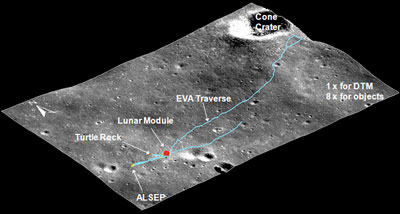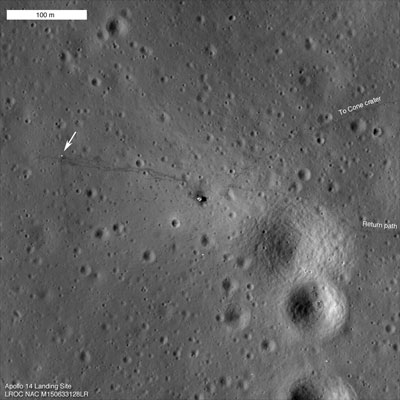Although the Apollo 14 mission to the moon was filled with incredible sights and was completely successful -- it met all its science goals -- the crew experienced a bit of a disappointment at missing the spectacular view from the rim of a 1,000-foot-wide crater. They might have gazed into its depths if they had the high-resolution maps now available from NASA's Lunar Reconnaissance Orbiter (LRO) spacecraft.

Credit: NASA/GSFC/Arizona State University/Ohio State UniversityAbove: Using two high-resolution LROC images taken from two separate orbits, a stereo image pair is formed for 3D measurements at the Apollo 14 landing site. Among the visible objects are the descent stage of the Apollo 14 lunar module Antares (highlighted with red dot), the Apollo Lunar Surface Experiments Package (yellow dot), a rock nicknamed Turtle Rock (brown dot), and multiple astronaut traverse footpaths clearly indicated by disturbed soils (blue lines).
Pressure was on the Apollo 14 mission, launched January 31, 1971, from the start. The Apollo 13 landing had to be aborted because an oxygen tank explosion crippled the spacecraft as it was on its way to the moon. It was a heroic effort just to return the crew safely to Earth, but the Apollo 14 team knew a second failure would probably result in cancellation of the remaining Apollo missions.
Although nothing as catastrophic as an explosion threatened their mission, the Apollo 14 crew had to improvise their way out of some tense situations.
On the way to the moon, the crew had to dock their spacecraft, the Command and Service Module "Kitty Hawk," to the spacecraft that would land on the moon, the Lunar Module "Antares." However, latches that would lock the two spaceships together refused to engage.
Kitty Hawk pilot Stuart Roosa tried the docking maneuver six times over more than an hour and a half before the latches activated, linking the spacecraft so that mission commander Alan Shepard and Antares pilot Edgar Mitchell could transfer to the Antares lander.
On the way down in Antares, the crew had to overcome computer and radar glitches in the system that was supposed to guide their landing. Even with the balky guidance system, they were able to pilot Antares to within 87 feet from the targeted landing point, at the time the most precise landing for the Apollo missions.

Credit: NASA/Goddard/Arizona State UniversityAbove: LROC NAC image of the Apollo 14 landing site acquired 25 January 2011. Click here for close-up showing LM descent stage (right) and ALSEP (arrow), note astronaut tracks between the two landmarks.
The site, which the crew named the "Fra Mauro Base," was the area to be explored by Apollo 13, a hilly zone about 300 miles from the edge of the 750-mile-wide Mare Imbrium basin formed long ago by the impact of a giant asteroid. The hills of Fra Mauro were believed to be made of rubble blasted from the Imbrium impact, and lunar geologists wanted the crew to collect rocks from the region so they could accurately date when giant impacts like Imbrium occurred on the moon.
Similar massive craters exist on Mercury and Mars, so it appears that the entire solar system experienced a chaotic period of "heavy bombardment" from enormous asteroids. Scientists were keen to date this event because it's very likely Earth was hit as well, and impacts of that scale would alter the evolution of life. However, on our world, such ancient craters have been erased by erosion from wind and water, as well as the recycling of the crust from its slow motion as a result of plate tectonics.
Shepard and Mitchell landed Feb. 5, and they performed two moonwalks, technically called "Extravehicular Activities," or EVAs, one on each day of the two days spent on the lunar surface. The first EVA went according to plan, with the deployment of the Apollo Lunar Surface Experiments Package, a suite of instruments that included a seismometer to measure moonquakes and laser reflectors to accurately measure changes in the Earth-moon distance using lasers fired from stations on Earth. During the second EVA, the crew hoped to reach the rim of Cone crater, a more recent impact crater about 1,000 feet wide a little over a mile from the Antares lander.
"An impact crater is like a drill," says Dr. James Rice of NASA's Goddard Space Flight Center, Greenbelt, Md. "The meteorite punches through layers of ground at the impact site and explodes, hurling this material outward. Surface material is scattered farthest, while the deepest material, which usually comes up in big chunks, remains closest to the crater rim. By collecting rocks as you get closer to a crater, you get a cross-section of the material beneath you without having to dig it up yourself."
"That's what the Apollo 14 crew did as they approached Cone crater – they wanted to get samples of the layers of rubble from the Mare Imbrium impact and see if Cone crater went deep enough to expose the bedrock beneath. The ejecta from the Imbrium impact where Apollo 14 landed may have come from up to 100 miles depth below the original lunar crust." Rice is an associate project scientist for LRO.
However, the terrain was hillier than expected, and the crew lost sight of the crater rim among the ridges of the hills. Eventually, they had to turn back because they needed to save enough oxygen and other supplies to return safely to the lander. At the time, they estimated they were close enough to the rim that rock samples collected where they stood would still represent the deep layers, but they were disappointed at missing the majestic view from the rim itself.
High-resolution photos of the area taken with LRO's Lunar Reconnaissance Orbiter Camera (LROC) reveal that they had come within about 30 yards of the rim, just a minuscule distance considering they had travelled over 250,000 miles to get there.
"The time lost in attempting to determine our exact position for collecting samples in order to satisfy the geologists, cost us significant time. We were essentially at the rim of Cone crater. We just didn't realize how close. It was just out of sight across the next rise a few yards away, when they decided our oxygen and water were too low to do anything but start back," said Antares pilot Edgar Mitchell.
"With the high-resolution photos we have from LRO today, combined with topographic maps made using LRO's laser-ranging instrument, they probably would have made it to the rim, because they would have known exactly where they were every step of the way," says Rice.
LRO has observed all the Apollo sites, and the LRO team is creating lunar maps with unprecedented accuracy that will guide future human and robotic explorers. The maps also will help identify unusual areas for a closer look, according to Rice, because they include data on mineral composition, water ice deposits, rough or unusual terrain, surface temperatures, and temperature changes.
Still, the Apollo 14 crew did an outstanding job with the maps available at the time, and the mission was a success, with nearly 100 pounds of rocks and soils collected and returned to Earth. Analysis of the decay of radioactive isotopes in the rocks dated giant impacts like Mare Imbrium at between 3.8 to 3.9 billion years old, about the time when life was emerging on Earth. The mission, which ended when the command module splashed down in the Pacific Ocean Feb. 9, 1971, still holds the record for the longest walk on the moon -- approximately 9,000 feet.














